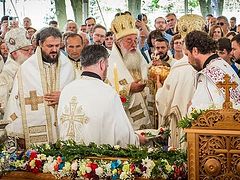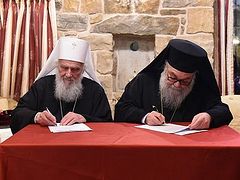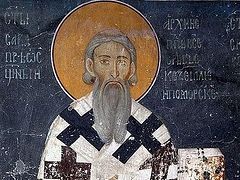Žiča, Serbia, October 8, 2019
The Serbian Church has been celebrating the 800th anniversary of its autocephaly throughout its canonical territory throughout the year.
The central event of the great jubilee was celebrated on Sunday, October 6 at Žiča Monastery with the participation of His Holiness Patriarch Irinej of Serbia and more than 40 other hierarchs of the Serbian Church from throughout the world, reports the press service of the Serbian Orthodox Church.
The monastery courtyard was too small to accommodate the flood of faithful pilgrims who arrived to celebrate the great event. Notable attendees included His Royal Highness Crown Prince Alexandar and Princess Katherine Karadjordjevic and a number of public officials.
Pat. Irinej addressed the gathered faithful with a primatial word, emphasizing that the foundation of the Serbian people and state is the saints of God, especially Sts. Symeon the Myrrh-gusher (Stefan Nemanja) and his son St. Sava, who secured an independent Church and state for the people.
Harmony has characterized Church-state relations in Serbia since then, Pat. Irinej said, while calling the people to return to the example of the great St. Sava.
“What we must emphasize today is that we must return to the way of Christ and the way of St. Sava. No one but the Lord is the Way, the Truth and the Life. Today, as we celebrate eight centuries of our autocephalous existence, we remember a time when the people listened to the word of their Church,” the Serbian Patriarch preached.
“Thank God we can celebrate this great day. It is important for us to know that our people have been adorned with unity, and we must cherish this unity in the Church, faith and love,” which is the message of this great anniversary, Pat. Irinej continued.
Following His Holiness’ word, an epistle of the Serbian hierarchy was then read out.
“St. Sava knew that the spiritual and cultural enlightenment of the faithful could be achieved only if a sufficient number of able and faithful bishops, priests, and monks were formed under one Church administration. Without a single Church structure and a unique spiritual space, the significant pastoral service of the Church for the salvation of the Fatherland and its people is simply impossible. In such political circumstances it was necessary that the Church should be self-sufficient, autocephalous,” the epistle reads.
“The fruits of this great event are undeniable and far-reaching. They mark our entire history in all areas of life, science, culture, spirituality and statehood—in a word, the identity and the very historical being and survival of our people. Under the aegis of the autocephalous Church, Archbishop Sava, based in the monastery of Žiča, managed to summon all the creative forces of the people … to embody the Gospel of Christ in every soul, in all relationships, in the whole life of the people,” the epistle continues.
A festive meal and a cultural and artistic program were offered to the hosts of pilgrims after the Divine Liturgy.




